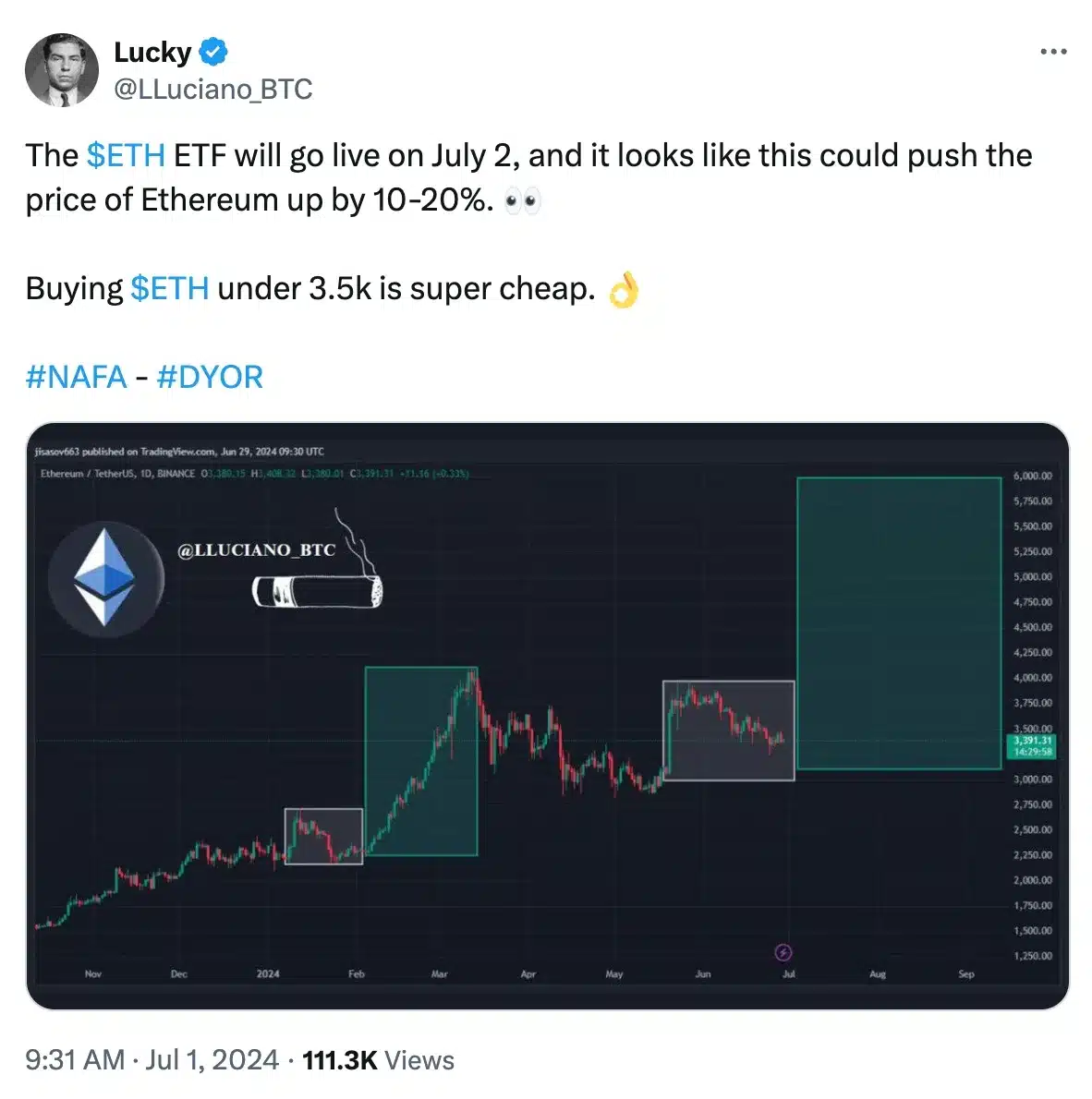- Ethereum ETFs faced significant outflows, raising concerns about investor interest and market performance.
- Bitcoin ETFs maintained their net inflows, despite recent weeks of continuous outflows.
September has proven to be an unfortunate month for the Bitcoin [BTC] ETF market. More concerning, however, is the underperformance of Ethereum [ETH] ETFs, which have struggled since their launch.
Ethereum ETF’s negative net flow
According to the latest update from Farside Investors, the ETH ETF experienced a net outflow of $6 million on the 6th of September.
While other ETFs like BlackRock’s ETHA and Fidelity’s FETH have seen inflows, Grayscale’s ETHE has faced such significant outflows that it has pushed the net flow into negative territory.
This raises a pressing question: Have Ethereum ETFs failed to attract the expected interest?
What’s behind this outflow streak?
To understand why investors are shying away from Ethereum ETFs, it’s crucial to examine several factors.
Unlike staking $ETH, which can yield a 1-5% annual percentage yield, holding an $ETH spot ETF limits this passive income opportunity.
Additionally, the Ethereum-to-Bitcoin ratio has fallen 50% over the past two years, leading many former ETH users to migrate to Layer 2 solutions or alternative, more cost-effective Layer 1 blockchains.
For instance, the $SOL/$ETH ratio has surged by 346%.
Ethereum has also become inflationary, as it now issues more $ETH than it burns, unlike Bitcoin’s capped supply of 21 million $BTC.
Recent updates, like the Proto-Danksharding upgrade, have further reduced Layer 2 transaction fees, decreasing Ethereum’s revenue.
Significant outflows from Grayscale’s ETHE are raising concerns and adding to the ETF’s negative net flow.
The anticipated surge in ETH’s price to $4,000 following the launch of Ethereum ETFs appears increasingly unlikely.

Source: Lucky/X
According to the latest update from CoinMarketCap, ETH, despite a 0.66% increase, is currently trading at $2,321—significantly below expectations.
Bitcoin ETF in comparison
In contrast, the Bitcoin ETF has seen a net inflow of $16.897 billion since its launch.
Despite Grayscale’s GBTC facing outflows, BlackRock’s ETF and other BTC ETFs have collectively achieved positive net inflows.
While there have been occasional days of outflows, it’s only in the past two weeks that Bitcoin ETFs have faced a sustained period of continuous outflow.
Thus, it remains to be seen whether the Ethereum ETF will flip from outflows to inflows, or if investors will continue to observe a persistent outflow trend.
- Ethereum ETFs faced significant outflows, raising concerns about investor interest and market performance.
- Bitcoin ETFs maintained their net inflows, despite recent weeks of continuous outflows.
September has proven to be an unfortunate month for the Bitcoin [BTC] ETF market. More concerning, however, is the underperformance of Ethereum [ETH] ETFs, which have struggled since their launch.
Ethereum ETF’s negative net flow
According to the latest update from Farside Investors, the ETH ETF experienced a net outflow of $6 million on the 6th of September.
While other ETFs like BlackRock’s ETHA and Fidelity’s FETH have seen inflows, Grayscale’s ETHE has faced such significant outflows that it has pushed the net flow into negative territory.
This raises a pressing question: Have Ethereum ETFs failed to attract the expected interest?
What’s behind this outflow streak?
To understand why investors are shying away from Ethereum ETFs, it’s crucial to examine several factors.
Unlike staking $ETH, which can yield a 1-5% annual percentage yield, holding an $ETH spot ETF limits this passive income opportunity.
Additionally, the Ethereum-to-Bitcoin ratio has fallen 50% over the past two years, leading many former ETH users to migrate to Layer 2 solutions or alternative, more cost-effective Layer 1 blockchains.
For instance, the $SOL/$ETH ratio has surged by 346%.
Ethereum has also become inflationary, as it now issues more $ETH than it burns, unlike Bitcoin’s capped supply of 21 million $BTC.
Recent updates, like the Proto-Danksharding upgrade, have further reduced Layer 2 transaction fees, decreasing Ethereum’s revenue.
Significant outflows from Grayscale’s ETHE are raising concerns and adding to the ETF’s negative net flow.
The anticipated surge in ETH’s price to $4,000 following the launch of Ethereum ETFs appears increasingly unlikely.

Source: Lucky/X
According to the latest update from CoinMarketCap, ETH, despite a 0.66% increase, is currently trading at $2,321—significantly below expectations.
Bitcoin ETF in comparison
In contrast, the Bitcoin ETF has seen a net inflow of $16.897 billion since its launch.
Despite Grayscale’s GBTC facing outflows, BlackRock’s ETF and other BTC ETFs have collectively achieved positive net inflows.
While there have been occasional days of outflows, it’s only in the past two weeks that Bitcoin ETFs have faced a sustained period of continuous outflow.
Thus, it remains to be seen whether the Ethereum ETF will flip from outflows to inflows, or if investors will continue to observe a persistent outflow trend.



















































































can i purchase generic clomiphene online order cheap clomiphene pill how to buy cheap clomiphene no prescription where buy cheap clomiphene pill can you buy cheap clomid for sale where can i buy generic clomid price clomiphene tablets price uk
The thoroughness in this break down is noteworthy.
The thoroughness in this section is noteworthy.
zithromax without prescription – order tinidazole pill buy metronidazole cheap
order semaglutide generic – order cyproheptadine sale periactin 4mg cheap
domperidone online buy – buy cyclobenzaprine 15mg generic buy cyclobenzaprine medication
buy propranolol paypal – order methotrexate 2.5mg online methotrexate 10mg brand
order amoxil – combivent 100 mcg drug cost combivent
cost amoxiclav – atbioinfo.com buy ampicillin online
nexium oral – https://anexamate.com/ buy generic esomeprazole 40mg
order warfarin for sale – coumamide cozaar 25mg oral
generic meloxicam 15mg – moboxsin.com buy meloxicam pills for sale
deltasone 20mg over the counter – https://apreplson.com/ prednisone 20mg pill
cheap amoxil generic – comba moxi buy amoxil without prescription
diflucan 200mg canada – https://gpdifluca.com/# buy fluconazole 100mg online
cenforce 50mg brand – https://cenforcers.com/ cenforce 50mg tablet
cialis daily vs regular cialis – https://ciltadgn.com/# teva generic cialis
zantac online – https://aranitidine.com/ order ranitidine generic
order viagra for men – https://strongvpls.com/# where to order viagra online
This is a keynote which is in to my verve… Myriad thanks! Quite where can I upon the acquaintance details an eye to questions? https://gnolvade.com/
More posts like this would make the online time more useful. https://ursxdol.com/sildenafil-50-mg-in/
This is the amicable of content I enjoy reading. https://prohnrg.com/product/loratadine-10-mg-tablets/
This is the kind of writing I truly appreciate. https://ondactone.com/simvastatin/
I am actually delighted to gleam at this blog posts which consists of tons of profitable facts, thanks towards providing such data.
baclofen us
I’ll certainly bring back to read more. http://iawbs.com/home.php?mod=space&uid=914827
buy generic forxiga – dapagliflozin uk buy forxiga 10 mg online
buy cheap xenical – janozin.com purchase xenical sale
Palatable blog you procure here.. It’s obdurate to on elevated worth writing like yours these days. I honestly comprehend individuals like you! Withstand guardianship!! http://sols9.com/batheo/Forum/User-Kknghw